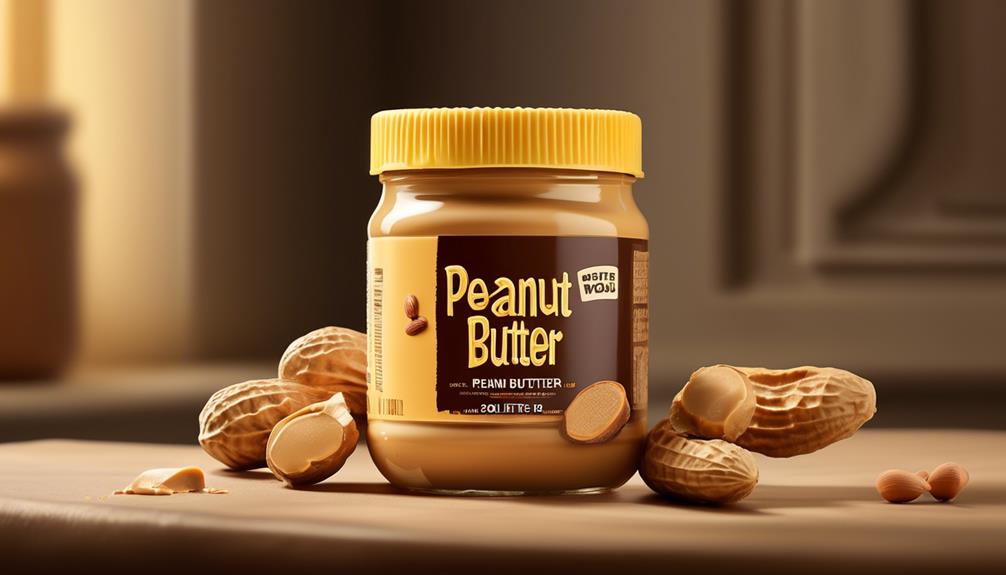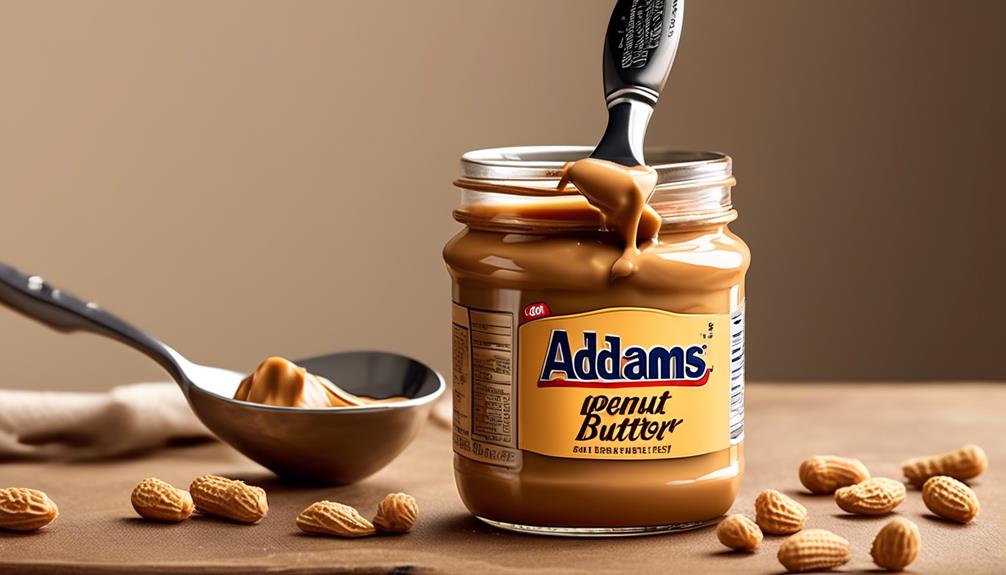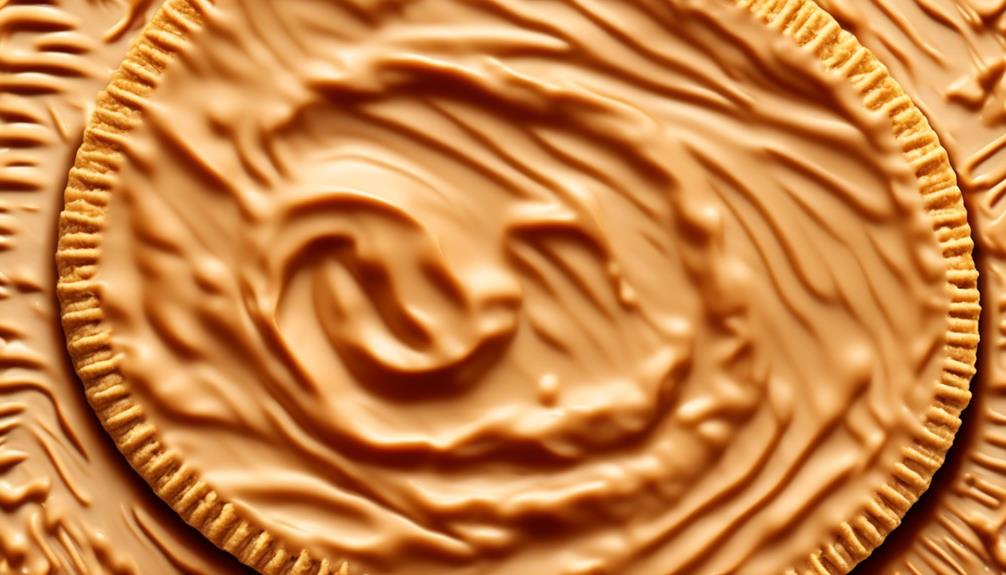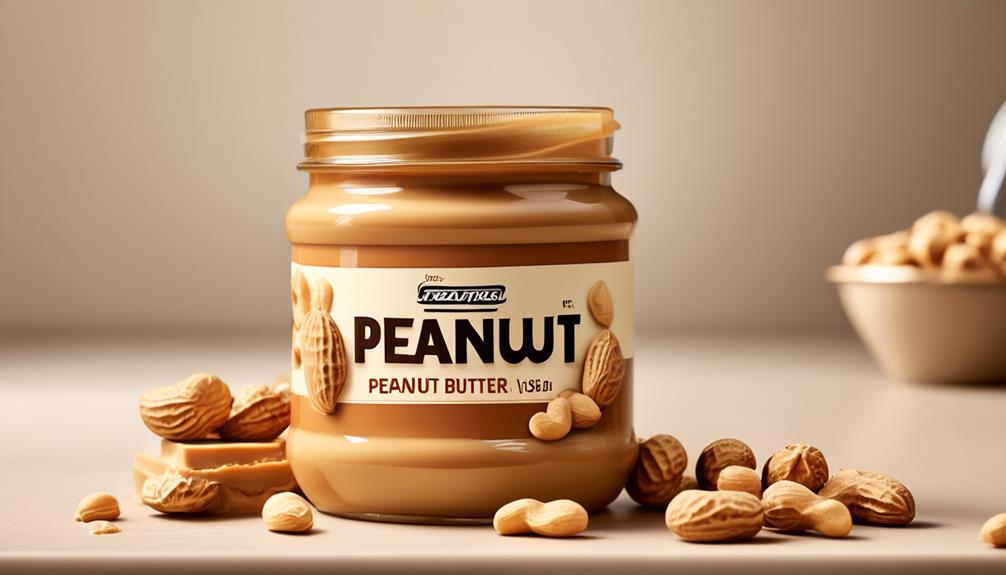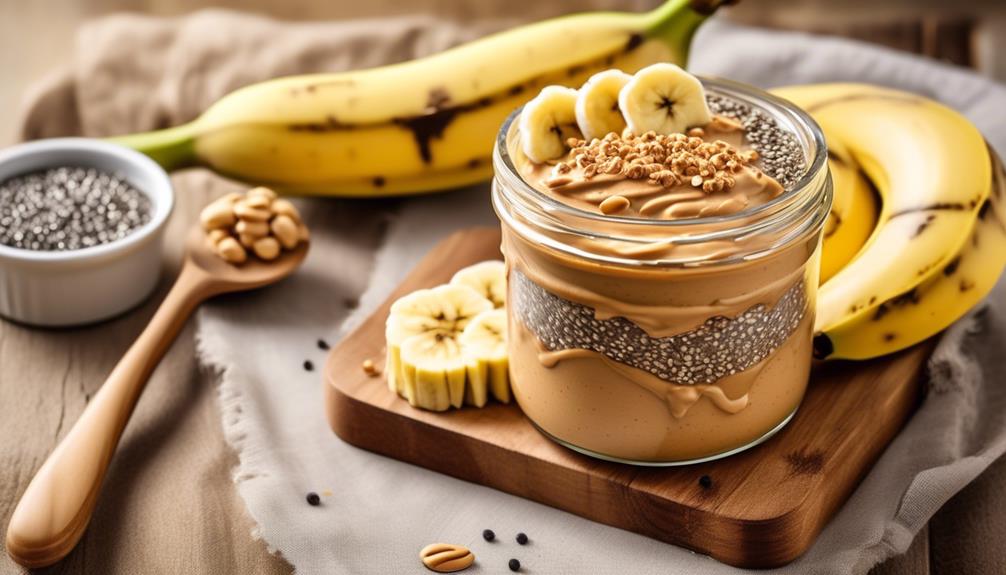Ever curious about what makes Reese’s peanut butter so irresistibly creamy and delicious?
Well, we've got the scoop on the peanut butter that Reese's uses in their iconic peanut butter cups and other delectable treats.
The choice of peanut butter is key to the distinctive taste and texture that Reese's is known for, and we're about to uncover the secrets behind this beloved ingredient.
So, grab a snack and get ready to uncover the mystery behind the peanut butter that makes Reese's treats so irresistible.
Key Takeaways
- Reese's uses high-quality peanuts as the primary ingredient in their peanut butter.
- They have a meticulous production process that includes roasting the peanuts to enhance flavor and grinding them to achieve a smooth and creamy texture.
- Reese's peanut butter is made with other ingredients such as sugar, hydrogenated vegetable oils, and salt, which are carefully sourced to maintain consistent quality and taste.
- Reese's is committed to sustainability and environmental impact reduction, promoting sustainable farming practices, waste reduction, and ethical sourcing of raw materials.
History of Reese's Peanut Butter Cups
Reese's Peanut Butter Cups, a confectionary marvel that has captivated taste buds for decades, traces its rich history back to the creative vision of its founder, Harry Burnett Reese. In the 1920s, Reese, a former dairy farmer, began experimenting with confections in his basement. His dedication to quality and innovation led to the creation of the iconic Reese's Peanut Butter Cups in 1928.
Inspired by his love for peanut butter and chocolate, Reese's original recipe combined creamy peanut butter with smooth milk chocolate, setting the stage for a timeless treat that continues to delight consumers today.
The success of Reese's Peanut Butter Cups can be attributed to Reese's commitment to using high-quality ingredients and perfecting the balance of sweet and salty flavors. The delectable combination of peanut butter and chocolate captured the hearts of consumers and quickly gained popularity.
Over the years, the brand has expanded its product line to include various sizes and formats, catering to different preferences and occasions. This rich history has solidified Reese's Peanut Butter Cups as a beloved and trusted confectionary choice for peanut butter and chocolate enthusiasts worldwide.
Ingredients Used in Reese's Peanut Butter

Using high-quality peanuts as the primary ingredient, Reese's Peanut Butter is carefully crafted to enhance the flavor and texture of various recipes and snacks.
This creamy peanut butter contains sugar, providing a delightful sweetness to complement its rich and creamy texture. Additionally, it includes hydrogenated vegetable oil, such as rapeseed oil, cottonseed oil, and soybean oil, which not only contributes to its consistency but also adds a depth of flavor.
The inclusion of salt in Reese's Peanut Butter is essential for balancing the sweetness and introducing a savory element, resulting in a well-rounded flavor profile.
Moreover, Reese's Peanut Butter is certified Kosher by the Orthodox Union (OU), ensuring that it meets the dietary guidelines and requirements of individuals who adhere to Kosher dietary laws.
These carefully selected ingredients not only make Reese's Peanut Butter a delectable addition to various recipes but also a delightful spread on its own.
The Peanut Butter Production Process

We begin by examining the peanut selection process, which is critical for ensuring the high quality of the final product.
Following this, we analyze the impact of roasting and grinding on the flavor and texture of the peanut butter.
These initial stages lay the foundation for the subsequent steps in the production process.
Peanut Selection
The peanut selection process is a critical initial phase in the production of high-quality peanut butter, ensuring that only the finest peanuts are used to create the desired flavor and texture.
This meticulous process involves several key steps:
- Careful Selection: Peanuts are meticulously chosen and thoroughly cleaned to eliminate any foreign materials, guaranteeing the highest quality for the peanut butter production.
- Roasting: The selected peanuts undergo a roasting process to enhance their flavor and aroma, contributing to the rich and distinctive taste of Reese's peanut butter.
- Monitoring and Processing: After roasting, the peanuts are cooled and meticulously ground and milled to achieve a smooth and creamy texture, ensuring the consistent quality of Reese's peanut butter.
This careful selection process sets the stage for the exceptional flavor and texture that distinguishes Reese's peanut butter.
Roasting and Grinding
After meticulously selecting and roasting the finest peanuts for Reese's peanut butter, the production process moves seamlessly into the critical stage of grinding to achieve the smooth and creamy texture that defines its signature taste. The grinding process involves carefully crushing the peanuts to release their natural oils and achieve the desired consistency. This step is crucial in creating the base for REESES Creamy Peanut Butter, ensuring its versatility in enhancing the flavor of various recipes and snacks while maintaining high quality and consistency. The roasted peanuts are ground and mixed with sugar, hydrogenated vegetable oil, salt, peanut oil, monoglycerides, molasses, and cornstarch to create the iconic REESES Creamy Peanut Butter. Below is a table outlining the key steps involved in the roasting and grinding process:
| Roasting and Grinding Process | |
|---|---|
| Step | Description |
| Selecting Peanuts | Meticulously choosing the finest peanuts for roasting. |
| Roasting | Enhancing the flavor and aroma of the peanuts through the roasting process. |
| Cooling and Grinding | Cooling the roasted peanuts and grinding them to a smooth and creamy texture. |
| Mixing Ingredients | Combining the ground peanuts with sugar, vegetable oil, salt, and other ingredients to create REESES Creamy Peanut Butter. |
Quality Control and Standards

We ensure the impeccable quality of our peanut butter through rigorous ingredient sourcing and production processes.
Our quality control and standards are upheld to maintain the smooth and creamy texture, rich flavor, and consistent taste of REESES Creamy Peanut Butter.
This ensures that our product meets the highest industry standards and delivers a consistently delightful experience to our customers.
Ingredients and Sourcing
Utilizing a meticulous sourcing process and stringent quality control measures, Reese's peanut butter is crafted with high-quality peanuts and carefully selected hydrogenated vegetable oils to maintain a consistent and superior standard of taste and texture.
The product is certified kosher by the Orthodox Union (OU), ensuring adherence to strict quality standards.
Additionally, the inclusion of specific sourcing details such as rapeseed oil, cottonseed oil, and soybean oil in the ingredient list guarantees a standardized and consistent product quality.
This attention to detail and adherence to high-quality standards make REESE'S peanut butter a versatile and trusted choice for various culinary applications.
With a reputation for quality and consistency, Reese's peanut butter stands out as a reliable and preferred ingredient for consumers seeking superior taste and texture.
Production and Testing
Implementing rigorous quality control measures throughout the production process ensures the consistency and safety of REESE'S Creamy Peanut Butter in every batch. Quality control standards are meticulously followed to monitor the sourcing and processing of high-quality peanuts. Testing procedures assess texture, taste, and sensory attributes to maintain the peanut butter's creamy and flavorful characteristics. Stringent standards guarantee that REESE'S Creamy Peanut Butter meets the brand's trusted reputation for delivering top-notch products. Our production and testing processes are designed to ensure that REESE'S Creamy Peanut Butter is versatile and suitable for a wide range of culinary applications, meeting consumer expectations and preferences.
| Quality Control Measures | Production Process | Testing Procedures |
|---|---|---|
| Monitoring sourcing and processing of high-quality peanuts | Ensuring consistency and safety | Assessing texture, taste, and sensory attributes |
Nutritional Content of Reese's Peanut Butter

The nutritional content of Reese's Peanut Butter reveals that a 2 tbsp serving contains 190 calories and is made with high-quality peanuts, along with 2% or less of hydrogenated vegetable oil, salt, and other ingredients. This makes it a substantial source of energy, with a rich and creamy taste that's characteristic of Reese's products.
The peanut butter also contains allergens such as peanuts and soy, and is certified Kosher by the Orthodox Union (OU), ensuring its quality and suitability for a diverse range of consumers.
Its versatility makes it a valuable ingredient for various recipes, from baking to savory dishes. Moreover, the smooth and creamy texture of Reese's Peanut Butter enhances the overall eating experience, whether spread on toast, used for making classic PB&J sandwiches, or incorporated into creative culinary creations.
With its balanced nutritional profile and delicious flavor, Reese's Peanut Butter continues to be a popular choice for consumers seeking a high-quality and indulgent peanut butter experience.
Unique Characteristics of Reese's Peanut Butter

Reese's Creamy Peanut Butter showcases a creamy texture that enhances the flavor of a wide range of snacks and recipes, such as PB&J sandwiches, smoothies, and celery sticks. The unique characteristics of Reese's Peanut Butter set it apart in the market, making it a preferred choice for many consumers. Below, we present a comparison table highlighting the distinct features of Reese's Peanut Butter.
| Unique Characteristics | Description |
|---|---|
| Creamy Texture | Elevates the taste experience and spreads easily. |
| High-Quality Ingredients | Made with premium peanuts, ensuring versatility in culinary applications. |
| Trusted Brand | Known for consistent taste and quality, providing reliability to consumers. |
| Culinary Versatility | Suitable for various recipes, adding depth and flavor. |
| Consumer Appeal | Widely recognized and popular, adding credibility to menus. |
Reese's Creamy Peanut Butter not only offers a creamy texture but also upholds high-quality standards, culinary versatility, and consumer appeal. These unique attributes make it a standout choice for both consumers and culinary professionals seeking premium peanut butter products.
Peanut Sourcing for Reese's Peanut Butter

Sourcing high-quality peanuts is crucial to ensuring the rich and delicious flavor of Reese's Peanut Butter, a key component in a variety of culinary applications.
When it comes to the peanut sourcing for Reese's Peanut Butter, the following key points shed light on the brand's approach:
- Quality Peanuts: Reese's sources high-quality peanuts to enhance the flavor of their peanut butter. This attention to quality ensures a superior taste and consistency in their products.
- Specific Blend of Oils: The peanut butter used in Reese's products is made with a specific blend of hydrogenated vegetable oils, including rapeseed, cottonseed, and soybean oils. This blend contributes to the creamy and smooth texture that Reese's Peanut Butter is known for.
- Certification: Reese's peanut butter is certified kosher by the Orthodox Union (OU), meeting high standards of quality and authenticity. This certification adds to the brand's credibility and reassures consumers of the product's quality.
These factors combined underscore Reese's commitment to using high-quality ingredients and their dedication to delivering a rich and delicious peanut butter flavor in all their products.
Sustainability Practices in Peanut Butter Production

We need to consider the sustainability of peanut butter production. This includes examining peanut sourcing practices, waste reduction efforts, and environmental impact mitigation.
Sustainable agricultural practices can play a significant role in promoting sustainability in peanut butter production. Techniques such as crop rotation and reduced tillage can minimize environmental impact and promote soil health.
In addition to agricultural practices, it is important to emphasize waste reduction and recycling in the production process. This can help minimize the environmental footprint of peanut butter production.
Ethical sourcing of raw materials is another key aspect of sustainable peanut butter production. Ensuring that peanuts are sourced from suppliers who follow responsible and sustainable practices is essential.
Peanut Sourcing Practices
Certified kosher and made with a blend of high-quality ingredients, including peanuts, sugar, and vegetable oil, the sourcing practices for the peanuts used in the production of Reese's peanut butter merit closer examination to assess their sustainability.
Peanut Sourcing Practices
- Transparency: The Hershey Company should provide detailed information about the sourcing of peanuts, including the regions and farms involved.
- Sustainability Initiatives: It's essential to explore the company's efforts in promoting sustainable and ethical practices within their peanut supply chain, such as supporting farmers and reducing environmental impact.
- Certifications: Understanding if the peanuts used in Reese's peanut butter are sourced from certified sustainable and responsibly managed farms, and if the company adheres to international standards like Fair Trade or Rainforest Alliance.
Investigating these aspects can offer insights into the environmental and social impact of Reese's peanut butter production, aiding consumers in making informed choices.
Waste Reduction Efforts
Implementing waste reduction efforts in peanut butter production is crucial for minimizing environmental impact and optimizing resource utilization throughout the manufacturing process.
Sustainability practices in peanut butter production focus on reducing energy consumption, water usage, and overall waste generation.
Peanut butter manufacturers may implement strategies such as recycling packaging materials and adopting eco-friendly packaging solutions to minimize their environmental footprint.
Additionally, sourcing peanuts from farms with sustainable agricultural practices and promoting biodiversity in peanut-growing regions are integral parts of waste reduction efforts.
Companies also invest in renewable energy sources to power manufacturing facilities, further contributing to waste reduction initiatives.
Environmental Impact Mitigation
Sustainable peanut butter production integrates various environmental impact mitigation strategies. These strategies include the use of sustainable farming practices, water conservation efforts, and energy-efficient processing.
One key aspect of sustainable peanut butter production is the use of sustainable farming practices. This involves implementing practices such as crop rotation, reduced tillage, and agroforestry. These practices help minimize the environmental impact of peanut cultivation by maintaining soil health, reducing erosion, and promoting biodiversity.
Water conservation is another important aspect of sustainable peanut butter production. Measures like drip irrigation systems, rainwater harvesting, and efficient water usage are employed to reduce water consumption. By implementing these measures, peanut butter producers can minimize their water footprint and contribute to water resource conservation.
Energy-efficient processing is also a crucial component of sustainable peanut butter production. Producers can implement renewable energy sources and optimize their production processes to reduce energy consumption. This not only helps mitigate the environmental impact but also contributes to the overall sustainability of the peanut butter production.
These strategies not only reduce the ecological footprint but also contribute to biodiversity conservation and waste reduction. By preserving natural habitats, promoting biodiversity, and avoiding harmful pesticides, sustainable peanut butter production aligns with the broader goal of environmental impact mitigation.
Comparisons With Other Peanut Butter Brands

In comparison to other peanut butter brands, REESE'S Creamy Peanut Butter stands out for its versatile use in various recipes and snacks, enhancing the flavor of PB&J sandwiches, fruit smoothies, and celery stick snacks. Its creamy texture elevates the taste, making it a preferred choice for those seeking a smooth and delectable peanut butter experience. Made with high-quality peanuts, REESE'S Creamy Peanut Butter is comparable to other popular brands like Jif and Skippy, both in ingredients and sugar content. The sugar content in REESE'S Peanut Butter is on par with other brands, suggesting a competitive standing relative to other peanut butter options. Positive reviews highlight the smooth, sweet, salty, and addictive taste of REESE'S Peanut Butter, making it a suitable choice for spreading, baking, and cooking.
| Aspect | REESE'S Creamy Peanut Butter | Jif | Skippy |
|---|---|---|---|
| Ingredients | Peanuts, Sugar, Oil | Peanuts, Sugar, Oil | Peanuts, Sugar, Oil |
| Texture | Creamy | Creamy | Creamy |
| Sugar Content | Comparable | Similar | Similar |
Consumer Preferences and Feedback

Consumer preferences and feedback significantly shape the success of products like REESE'S Creamy Peanut Butter, guiding product tailoring to meet the desires and needs of the target market. Understanding and incorporating consumer preferences and feedback is crucial for the sustained success of peanut butter products.
Here are key insights into consumer preferences and feedback for peanut butter products like REESE'S:
- Taste: Consumer feedback indicates a strong preference for a rich, nutty flavor with a hint of sweetness in peanut butter products.
- Texture: Many consumers express a preference for a creamy and smooth texture in peanut butter, creating a delightful mouthfeel.
- Nutritional Content: There's a growing demand for peanut butter products that are free from additives and preservatives, with a focus on natural ingredients such as SOYBEAN OIL.
Frequently Asked Questions
Does Reese's Use Real Peanut Butter?
Yes, REESE'S uses real peanut butter in its products. The creamy texture and addictive taste stem from high-quality peanuts, sugar, and other key ingredients.
Reviewers describe it as smooth, sweet, salty, and peanutty, making it versatile for various recipes and snacks. Its real peanut butter content contributes to its nutty and flavorful twist, suitable for spreading, baking, and cooking, enhancing the overall taste of dishes.
Is Reese's Peanut Butter Just Normal Peanut Butter?
Yes, REESES Peanut Butter is distinct from normal peanut butter. It boasts a creamy texture that enhances its taste, setting it apart from traditional peanut butter.
Its blend of high-quality peanuts, sugar, hydrogenated vegetable oil, salt, peanut oil, monoglycerides, and molasses creates a unique flavor profile that adds depth to various recipes.
The addictive taste and creamy consistency make it a versatile and sought-after ingredient.
What Is in Reese's Creamy Peanut Butter?
Reese's Creamy Peanut Butter contains high-quality peanuts, sugar, hydrogenated vegetable oil, salt, and other ingredients. It's a versatile ingredient, perfect for enhancing PB&J sandwiches, fruit smoothies, and snacks with its creamy texture.
The allergen information discloses that it contains peanuts and soy, and it's certified Kosher by the Orthodox Union.
With about 16 servings per container and 190 calories per serving, it's a trusted brand known for its peanut butter products.
Does Reese's Make Peanut Butter in a Jar?
Yes, REESE'S does make peanut butter in a jar. It's a versatile and high-quality ingredient suitable for various recipes and snacks, including PB&J sandwiches, smoothies, and celery stick snacks.
Made with high-quality peanuts, it has a creamy texture that enhances the taste of dishes and snacks. Each serving contains about 190 calories, with approximately 16 servings per container.
It's a flavorful peanut butter option and is certified kosher, part of the trusted REESE'S brand.
Conclusion
In conclusion, Reese's uses a creamy and high-quality peanut butter that adds a rich and flavorful twist to various snacks and recipes. Like a key ingredient in a recipe, their peanut butter enhances the overall experience and leaves a lasting impression.
With its versatile use and delicious taste, Reese's peanut butter stands out in the industry and continues to be a top choice for consumers.

